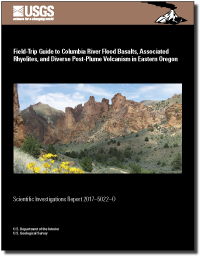Field-trip guide to Columbia River flood basalts, associated rhyolites, and diverse post-plume volcanism in eastern Oregon
Links
- Document: Report (23.5 MB pdf)
- Larger Work: This publication is Chapter O of Field-trip guides to selected volcanoes and volcanic landscapes of the western United States
- Download citation as: RIS | Dublin Core
Abstract
The Miocene Columbia River Basalt Group (CRBG) is the youngest and best preserved continental flood basalt province on Earth, linked in space and time with a compositionally diverse succession of volcanic rocks that partially record the apparent emergence and passage of the Yellowstone plume head through eastern Oregon during the late Cenozoic. This compositionally diverse suite of volcanic rocks are considered part of the La Grande-Owyhee eruptive axis (LOEA), an approximately 300-kilometer-long (185 mile), north-northwest-trending, middle Miocene to Pliocene volcanic belt located along the eastern margin of the Columbia River flood basalt province. Volcanic rocks erupted from and preserved within the LOEA form an important regional stratigraphic link between the (1) flood basalt-dominated Columbia Plateau on the north, (2) bimodal basalt-rhyolite vent complexes of the Owyhee Plateau on the south, (3) bimodal basalt-rhyolite and time-transgressive rhyolitic volcanic fields of the Snake River Plain-Yellowstone Plateau, and (4) the High Lava Plains of central Oregon.
This field-trip guide describes a 4-day geologic excursion that will explore the stratigraphic and geochemical relationships among mafic rocks of the Columbia River Basalt Group and coeval and compositionally diverse volcanic rocks associated with the early “Yellowstone track” and High Lava Plains in eastern Oregon. Beginning in Portland, the Day 1 log traverses the Columbia River gorge eastward to Baker City, focusing on prominent outcrops that reveal a distal succession of laterally extensive, large-volume tholeiitic flood lavas of the Grande Ronde, Wanapum, and Saddle Mountains Basalt formations of the CRBG. These “great flows” are typical of the well-studied flood basalt-dominated Columbia Plateau, where interbedded silicic and calc-alkaline lavas are conspicuously absent. The latter part of Day 1 will highlight exposures of middle to late Miocene silicic ash-flow tuffs, rhyolite domes, and calc-alkaline lava flows overlying the CRBG across the northern and central parts of the LOEA. The Day 2 field route migrates to southern parts of the LOEA, where rocks of the CRBG are associated in space and time with lesser known and more complex silicic volcanic stratigraphy associated with middle Miocene, large-volume, bimodal basalt-rhyolite vent complexes. Key stops will provide a broad overview of the structure and stratigraphy of the middle Miocene Mahogany Mountain caldera and middle to late Miocene calc-alkaline lavas of the Owyhee basalt. Stops on Day 3 will progress westward from the eastern margin of the LOEA, examining a transition linking the Columbia River Basalt-Yellowstone province with a northwestward-younging magmatic trend of silicic volcanism that underlies the High Lava Plains of eastern Oregon. Initial field stops on Day 3 will examine key outcrops demonstrating the intercalated nature of middle Miocene tholeiitic CRBG flood basalts, prominent ash-flow tuffs, and “Snake River-type” large-volume rhyolite lava flows exposed along the Malheur River. Subsequent stops on Day 3 will focus upon the volcanic stratigraphy northeast of the town of Burns, which includes regional middle to late Miocene ash-flow tuffs, and lava flows assigned to the Strawberry Volcanics. The return route to Portland on Day 4 traverses across the western axis of the Blue Mountains, highlighting exposures of the widespread, middle Miocene Dinner Creek Tuff and aspects of Picture Gorge Basalt flows and northwest-trending feeder dikes situated in the central part of the CRBG province.
Suggested Citation
Ferns, M.L., Streck, M.J., and McClaughry, J.D., 2017, Field-trip guide to Columbia River flood basalts, associated rhyolites, and diverse post-plume volcanism in eastern Oregon: U.S. Geological Survey Scientific Investigations Report 2017–5022–O, 71 p., https://doi.org/10.3133/sir20175022O.
ISSN: 2328-0328 (online)
Study Area
Table of Contents
- Preface
- Contributing Authors
- Abstract
- Introduction
- Columbia River Basalt Group
- La Grande-Owyhee Eruptive Axis
- Pre-Tertiary Basement Rocks
- Graben Structures
- Northern Part of the La Grande-Owyhee Eruptive Axis
- Southern Part of the La Grande-Owyhee Eruptive Axis
- Volcanism West of the LOEA: Strawberry Volcanics—High Lava Plains
- Strawberry Volcanics
- Regionally Widespread Late Miocene Ash-Flow Tuffs of the High Lava Plains
- Icelandites
- Field-Trip Stop Descriptions and Road Log
- Day 1. Columbia River Basalt Group and Northern Part of the La Grande-Owyhee Eruptive Axis
- Day 2. Southern Part of the La Grande-Owyhee Eruptive Axis and Lake Owyhee Volcanic Field
- Day 3. Transect from Western Margin of La Grande-Owyhee Eruptive Axis and Oregon-Idaho Graben through Southern Margin of Strawberry Volcanics to John Day
- Day 4. Picture Gorge Basalt, “Southern” Columbia River Basalt Group, Monument Dike Swarm, and John Day Fossil Beds
- Acknowledgments
- References Cited
| Publication type | Report |
|---|---|
| Publication Subtype | USGS Numbered Series |
| Title | Field-trip guide to Columbia River flood basalts, associated rhyolites, and diverse post-plume volcanism in eastern Oregon |
| Series title | Scientific Investigations Report |
| Series number | 2017-5022 |
| Chapter | O |
| DOI | 10.3133/sir20175022O |
| Publication Date | August 09, 2017 |
| Year Published | 2017 |
| Language | English |
| Publisher | U.S. Geological Survey |
| Publisher location | Reston, VA |
| Contributing office(s) | Volcano Science Center |
| Description | xiii, 71 p. |
| Country | United States |
| State | Oregon |
| Other Geospatial | Columbia River Basalt Group |
| Online Only (Y/N) | Y |


